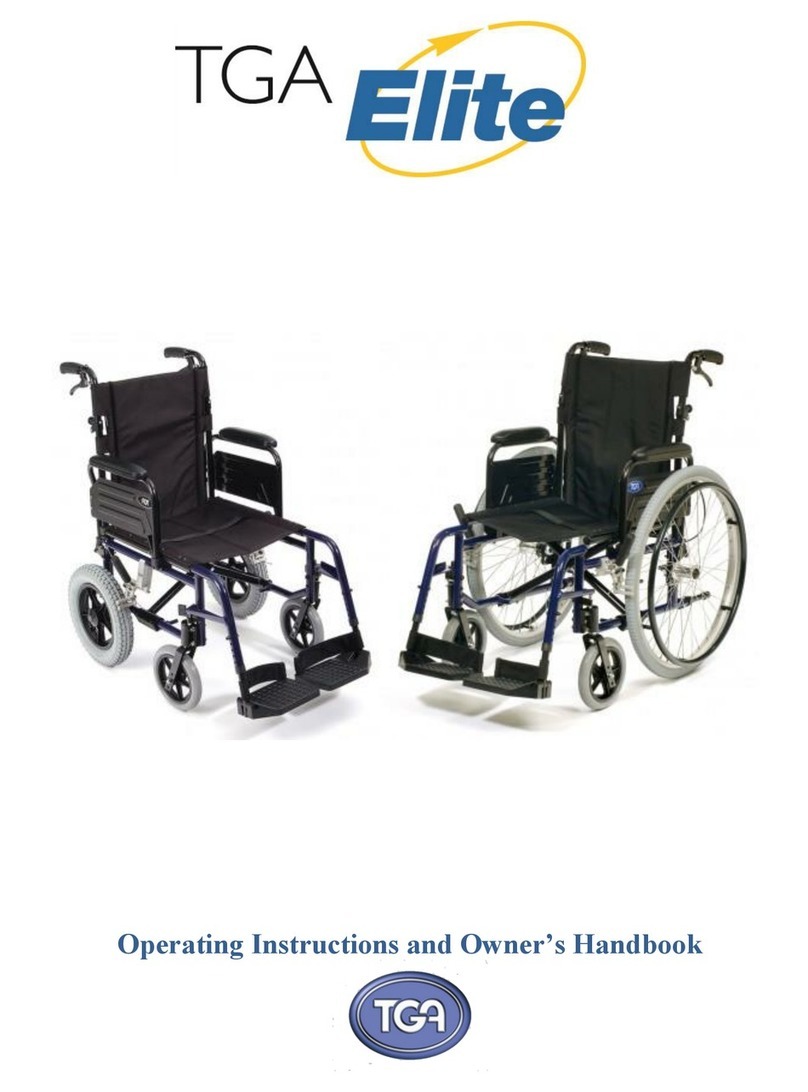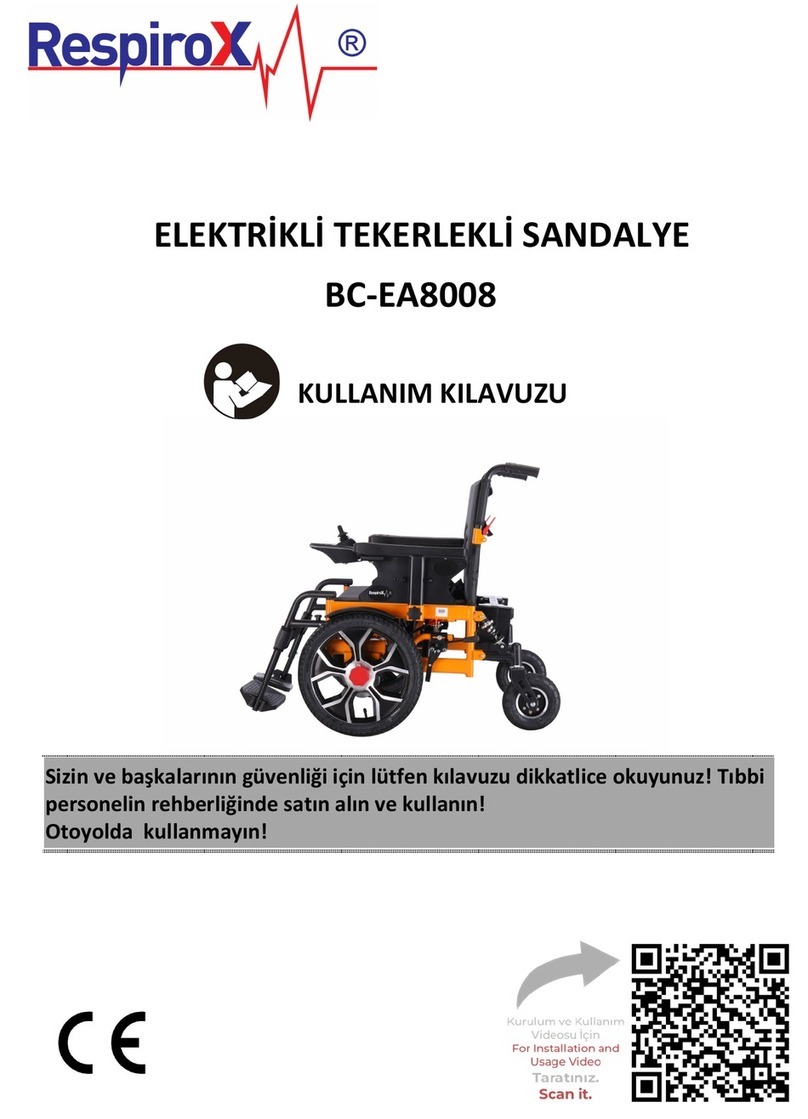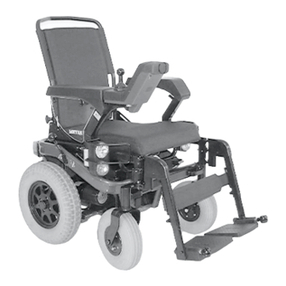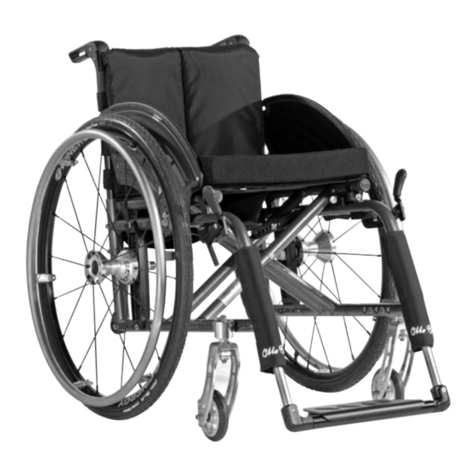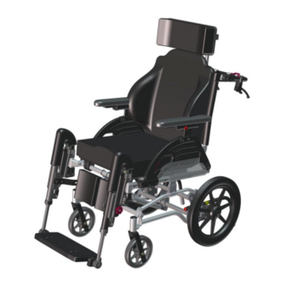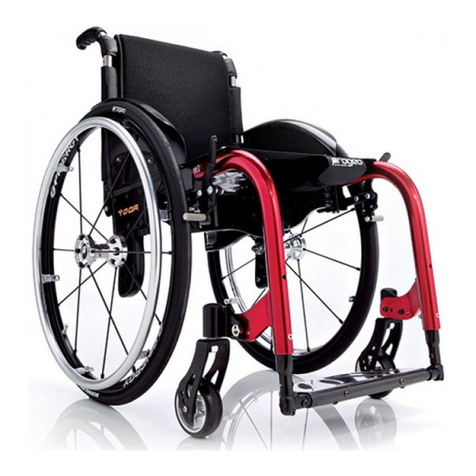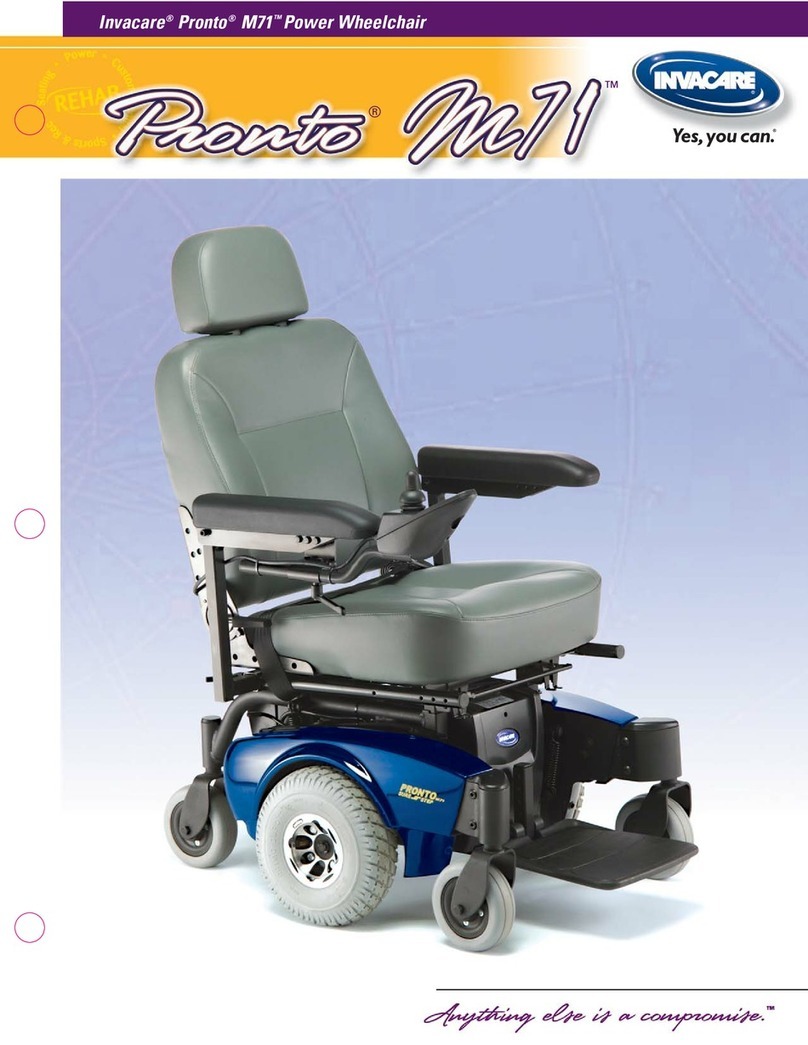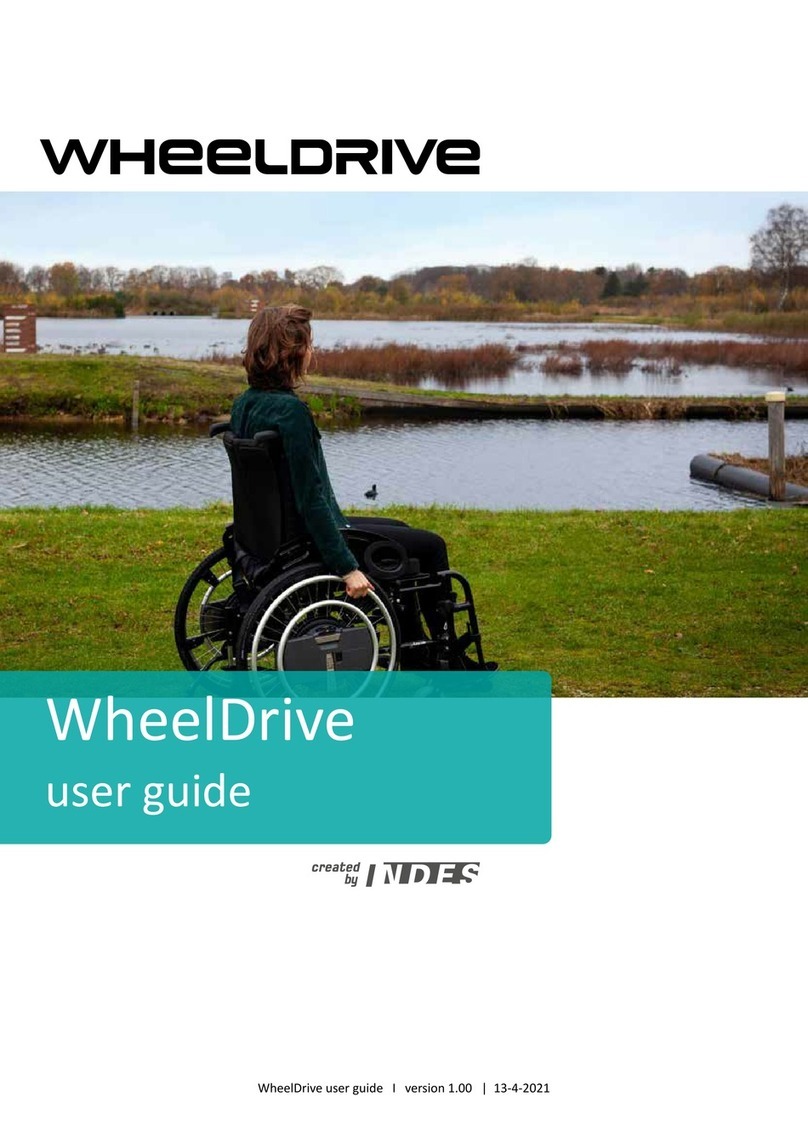TGA POWERPACK Quick start guide

POWERPACK
Operating Instructions
and Owner’s Handbook

Introduction page 3
Components of your Powerpack page 3
General instructions page 4
Fitting instructions page 5
Additional fitting hints page 8
Controls page 9
Using the Powerpack page 10
Batteries page 11
Battery charging page 12
Transportation page 13
Warranty page 13
Warranty exclusions page 14
Contents
23

This manual provides important operational and maintenance information. Please take the
time to read in full before venturing out with your new Powerpack.
Important safety related issues will be drawn to your attention with this warning symbol:
WARNING!
Please keep this manual in a safe place for future reference.
This manual includes fitting instructions but we advise fitting and setup by your supplier.
Please keep the instructions in a safe place for reference in case the Powerpack needs to be
fitted to a different wheelchair. Please make a note of the Powerpack serial number, date of
purchase and the place of purchase in the notes section on page 15.
Introduction to your Powerpack
Product overview
The TGA Powerpack encompasses all of the tried and tested technology of the previous
versions along with some exiting new developments. Over years of development, TGA has
designed a wide range of fitting kits to ensure the Powerpack fits the majority of wheelchairs
in seconds. Once fitted, the Powerpack provides powered motion, significantly reducing the
effort required to propel the wheelchair and its occupant. Its customer friendly fitting and
removal system means it can be easily removed for transit and refitted with ease.
Your TGA Powerpack is designed to be used indoors and outdoors in conjunction with a
manual wheelchair. Operated by an attendant only, it can be used by a range of clients,
where the ability to self propel in a manual wheelchair is no longer possible.
Items included with your Powerpack
• Powerpack
• Wheelchair mounting brackets
• Hand control
• Handelbar grips or alternate mount bracket
• Battery in bag
• T-bar 5mm allen key
• 6mm allen key
• 2 x ignition keys
WARNING!
• Do not carry passengers or exceed the maximum carrying weight. (see general
instructions on page 4)
• Do not operate your Powerpack when under the influence of alcohol or certain
drugs, which may impair your safety.
• Do not operate your Powerpack through deep water or clean with a high pressure
hose.
23

General instructions
1. These instructions apply to all four
models of Powerpack. The Solo and Duo
models are suitable for use when the
wheelchair occupant weight is up to 18
stone/114kg. The Heavy Duty model is
suitable for use when the occupant weighs
up to 26 stone/165kg and the Plus model
has a 32 stone/203kg max user weight.
2. The Solo Powerpack complete with
battery weighs 13.1 kg (28.8 lbs), Duo
model 14.5 kg (31.9 lbs), the Heavy Duty
16.05 kg (35.3 lbs) and the Plus 18kg
(40lbs). Please refer to the wheelchair
manufacturer’s handbook for the maximum
user weight limits of the wheelchair.
3. Please read these instructions very
carefully before unpacking the Powerpack or
attempting to fit it on a wheelchair.
4. As the Powerpack and its associated
components are relatively heavy and fitted
at a low level, great care must be taken not
to strain when lifting and assembling on to
wheelchairs.
5. Remove the Powerpack from the box first,
then remove the battery. Do not remove
both together in case the battery slips,
causing damage or personal injury.
6. Check you have all contents as listed:
• Powerpack with lifting strap
• Battery in bag complete with leads
• Battery charger
• Crossbar
• 2 Mounting brackets, left and right hand
• Right-hand handgrip with control*
• Left-hand handgrip*
• Allen key ‘T-bar’ 5mm
• Allen key 6mm
• 2 keys
• User manual
• Warranty card
7. Always fit Powerpack to wheelchair first
and then fit battery.
8. Always remove the battery from
Powerpack before disassembling from the
wheelchair.
9. Always ensure the on/off key is in the off
position when connecting or disconnecting
the battery.
10. Never operate the Powerpack without
the chair being occupied.
11. The Powerpack is very simple to install
and use. However, if you have any problems
regarding fitting and use, please seek
advice from a competent engineer or TGA.
12. Refer to section “Using the Wheelchair
Powerpack” and the wheelchair
manufacturer’s instructions (wheelchair
handbook) before using the Powerpack for
the first time.
13. Once fitted correctly to the wheelchair,
the Powerpack will make life a lot easier
and take much of the effort out of pushing
a wheelchair. Use it all of the time to power
the chair or just when the going gets tough.
The Powerpack is very capable of powering
up gentle hills without assistance and
steeper hills can be climbed with assistance
from the attendant. However, depending on
the weight of the occupant and gradient of
the hill, some hills may be too much for the
Powerpack to cope with. The Powerpack
has various built-in protection circuits to
stop serious damage to the motor and
WARNING!
• Always ensure there is an air gap
between the Powerpack battery and
the seat base with the user seated.
• Always ensure the on/off key is in
the off position before anyone sits
in or alights from the wheelchair.
• On wheelchairs with seats that can
be adjusted into a reclining position,
(tilt in space), always ensure that
the lowest part of the seat is not
touching any part of the Powerpack
or its battery with the wheelchair
user seated.
• Always ensure there is nothing
resting on the Powerpack or its
battery pack.
* Your kit may have an alternative mount bracket to
replace the extended right and left handgrips.
45

Fitting instructions
1. Remove the Powerpack and all associated
components from the packaging.
2. Both time and care must be taken
to ensure the Powerpack is set up in
accordance with these instructions and
fitted in the position that best suits the
particular chair it is being fitted to, both for
ease of use and safety.
3. Ideally the Powerpack should be
positioned so that the centre of the drive
wheel/s runs approximately in line with the
centre of the wheelchair rear wheels, Fig 1
A-A (single and twin wheel models). This
is not possible on some chairs, so it may
have to be positioned more towards the
rear but be aware that the further towards
the rear it is fitted, the greater chance of it
causing discomfort to the attendant whilst
walking. Fit it as far forward as possible,
but never fit forward of the wheelchair rear
wheels. The drive wheel (or wheels if a Duo)
should always be set to run in the centre
of the wheelchair (Fig 1 B-B). Twin wheel
models should have a wheel running equal
distance either side of the centre line of the
wheelchair (Fig 1 B-B).
Fig 1 Powerpack tting and bracket location diagram
4. Take the two mounting brackets and you
will see that one has a larger diameter shaft
than the other (Fig 2 C & D). Fit the larger
diameter right-hand mounting bracket to
the bottom of the wheelchair frame on the
right-hand side, as viewed from the rear. Fit
the smaller diameter left-hand bracket in
a corresponding position on the left-hand
side of the chair. Fig 1 demonstrates the
approximate positioning of the mounting
brackets on the chair (when viewed from
above). Do not tighten at this stage.
the electronics if for whatever reason an
overload occurs. At this point the motor will
shut down and you will have to switch the
key off, wait a few seconds and switch back
on to clear.
However, in order to carry on climbing
the gradient, a lot more effort will have to
be put into pushing in order to assist the
Powerpack and stop it shutting down again.
If the Powerpack does shut down more
than once, we would strongly recommend
that you find an alternative route as the
Powerpack will be trying to work outside its
design limitations and continual use may
cause damage.
14. The Powerpack is not designed to climb
steep gradients, nor to take you anywhere
under power assistance that you would not
normally be able to push the chair without
using powered assistance. It must be
remembered that even if the chair can be
powered uphill, you still have to get down
the other side which can sometimes be
even more difficult. We strongly recommend
the fitting of attendant controlled brakes
to your wheelchair if moderately steep or
long slopes are likely to be negotiated, the
wheelchair user is heavy or there are steep
pavement cambers to negotiate.
15. Range is dependent on various factors,
such as weight of occupant, number of
hills and the gradient of hills encountered
on your journey. In addition, how much
assistance the attendant gives to push the
wheelchair will affect the range. We strongly
recommend that initially, journey distances
are relatively short and are gradually
increased. This will allow the opportunity
to become used to the controls and get to
know the range provided by the battery on
your local terrain.
Note – The Powerpack should not be used
on gradients greater than the maximum
stated by the wheelchair manufacturer.
WARNING!
If this occurs the full weight of the chair
and its occupant will immediately be
transferred to the attendant until the
Powerpack resumes drive.
45

Fig 2 Crossbar assembly (front view)
5. Take the two crossbar tubes. Insert
the smaller diameter tube into the larger
diameter tube at the hand wheel end (Fig
2E). Fit the larger diameter tube over the
right-hand mounting bracket (Fig 2C).
Now compress the smaller diameter tube
against the spring and offer it up to the
left-hand mounting bracket. Allow the
spring to extend the tube over the bracket.
Please note that the crossbar on the Heavy
Duty model is not spring loaded, only the
Solo and Duo model has a spring loaded
crossbar. Take care when using the crossbar
as it is spring loaded and could cause
damage or injury if not used correctly. Avoid
over tensioning the spring by pushing the
inner tube in more than necessary. Avoid
pointing at anyone. Take care when fitting.
Please note: On some heavy duty and
some specialist wheelchairs it may be found
that the crossbar is a little too long. Please
consult your dealer or TGA.
6. Ensure the wheelchair is fully open (see
wheelchair manufacturer’s handbook). Adjust
the position of the clamps so that they
are directly opposite each other and the
crossbar is at right angles to the wheelchair
frame. Now lightly tighten the clamp
retaining bolts with the allen key provided.
A. Crossbar housing
B. Crossbar
C. Mounting bracket - right hand
D. Mounting bracket - left hand
E. Hand wheel
F. Crossbar wing nut
7. Compress the crossbar and remove from
the wheelchair. Now hold the Powerpack so
that the wheel is making contact with the
ground and the crossbar housing is pointing
away from you. Keeping the crossbar hand
wheel to the left, insert the crossbar into the
crossbar housing tube at the front of the
motor.
8. Ensure wheelchair brakes are on and fit
the Powerpack complete with crossbar on
to the wheelchair by holding it in position
and placing the right-hand end of the
crossbar over the mounting bracket (Fig 3).
Allow the spring to extend the left-hand
tube over the other mounting bracket and
lightly tighten the hand wheel (Fig 2E). To
avoid damaging the crossbar, do not over
tighten. The crossbar must always be fully
extended against the mounting brackets to
ensure safe attachment to the wheelchair
frame. The wheelchair should always be fully
extended prior to attaching the Powerpack
and once the chair has been sat in, ensure
that it has not expanded further and that the
crossbar remains fully extended against the
mounting brackets.
Fig 3 Attaching crossbar
9. Check the alignment with the rear wheels
and centre line of the wheelchair (see
paragraph 3). Now firmly tighten the clamp
bolts on the crossbar mounting brackets.
Next, ensure the crossbar is firmly against
the mounting bracket shoulders and then
tighten the crossbar hand wheel taking
care not to damage the crossbar by over
tightening. The drive wheel or wheels can
be centralized between the wheelchair
wheels by sliding the motor assembly along
the crossbar. After centralising, tighten the
crossbar wing nut (Fig 2F). Again, take care
not to over tighten.
NOTE:
When using the Powerpack in
conjunction with the TGA Strongback
wheelchair, these brackets are integral
to the frame and do not require fitting.
67

10. When using the Powerpack for the first
time, if the wheelchair pulls to the left or
right it is usually because the drive wheel
or wheels are not central. To remedy this,
simply adjust the Powerpack on the crossbar
as in Paragraph 9 until the wheelchair pulls
in a straight line. Similarly, if the mounting
brackets have not been fitted directly
opposite each other, this will also cause the
wheelchair to pull to one side or the other.
9. Place the battery in the tray with the
writing on the bag uppermost and the
handle towards you. The battery bag is
securely held in place by Velcro (Fig 4).
Fig 4 Fitting and connecting battery
10. The next item to fit is the handlebar
control (Fig 5). This unit performs many
functions in addition to controlling the
motor.
Fig 5
11. The handlebar control can be fitted to
either the alternative mount bracket, which
fits to the standard wheelchair handle bar,
in front of the handgrip, or to the extended
handlebar grips supplied by TGA as an
additional kit.
12. If fitting the extended handlebar
grips, they replace the original wheelchair
handlebar grips as well as providing
extension handlebars for added comfort
when controlling the chair. If the handlebar
control is received fitted to the extension, it
is usually set for right-hand use but can be
reset for left-hand operation.
13. To fit the extended handlebar grips,
both handlebar grips need to be removed
from your wheelchair with care. Taking
each new handlebar grip in turn, remove
the rubber end caps and engage the long
4mm allen key T bar into the expander bolt
located approximately half way down the
inside of the new handlebar grip. Looking in
the other end of the handlebar grip, you will
see an expanding bolt, which is the retainer
for locking the new handlebar grip onto the
wheelchair handlebar. With the allen key
T bar, unscrew the expander bolt so that
the four expanding arms are unexpanded
and flush with the internal barrel (until
approximately a quarter of the bolt thread
is left in the internal barrel). You may need
to hold your finger on the barrel while this
is taking place to prevent it turning. Keep
the allen key T bar located in the expander
bolt, as this makes fitting easier and now
slide the new grip fitted with the control
onto the right-hand wheelchair handlebar
(Fig 5). The new grips are obviously longer
than the ones removed and this enables
the original handlebars to be extended.
This is sometimes useful when fitting the
Powerpack to give more clearance for
your feet. Now tighten the expander bolt
as much as you can using the long allen
key T bar. The control unit should now be
in a vertical location. Repeat for the other
handlebar grip. Please note: to ensure a
positive fitting, at least 7.5 cm (3 inches) of
the wheelchair handlebar must be covered
by the new grip.
A
F
E
B
C
D
67

Additional fitting hints
WARNING!
The correct fitting of the new
handlebar grips and control unit
is essential to the control of the
wheelchair and safety of the occupant.
Please read these fitting instructions
very carefully and if you are in any
doubt or require any assistance please
contact your dealer or TGA.
14. If you require the wheelchair to be
operated from the left-hand side simply
remove the backing plate at the top of the
handlebar, under the plate are two bolts
which hold the control to the handlebar
grip. Remove the control and re-fit to the
left-hand grip with the allen key T bar
provided.
15. Connect the plug into the socket at the
base of the handlebar control. Ensure that it
connects positively (Fig 5E).
16. Connect the battery plug and socket to
the plug and socket from the controller. This
can only be done one way, red to red and
black to black (Fig 4).
17. Take the loop at the top of the lifting
strap and place it over the left handlebar
of the wheelchair. You will note a two piece
buckle in the strap. When the two parts
of the buckle are fastened in the closed
position it will create a loop in the strap.
Make sure the buckle is open and that the
strap is just a straight length. Now take the
strap adjuster and alter as necessary the
length of the strap by pulling it through the
adjuster until the wheel of the Powerpack
sits firmly on the ground and the strap is
just slack. Allow enough slack so that the
Powerpack has approximately one inch of
downward movement, sufficient to cope
with rough terrain or potholes. To lift the
Powerpack wheel clear of the ground,
simply raise the Powerpack by pulling up
the strap below the buckle. Now fasten the
two parts of the buckle together and this will
hold the Powerpack securely off the ground.
To lower the Powerpack on to the ground,
support the unit by holding the lower part
of the strap, release the buckle and gently
lower the Powerpack. Always ensure that the
strap does not foul any moving components
and that it is always attached to the
handlebar; particularly make sure that the
strap doesn’t foul on any attendant brake
levers.
1. The Powerpack is normally fitted between
the two horizontal tubes of the wheelchair
frame. If this is not possible, it can be fitted
between vertical or diagonal tubes.
2. The angle that the Powerpack is mounted
at is important in terms of performance. To
check that the Powerpack is mounted at the
correct angle, measure from the bottom of
the crossbar housing to the ground (to do
this the Powerpack should be fitted to the
wheelchair and on even terrain). Ideally, this
distance should be between 12.5 to 16.5
cm (5 to 6.5 inches approximately). If this
distance is less than 12.5 cm, the front of the
Powerpack is too low. This is most likely to
occur on wheelchairs with very small wheels
or a particularly low frame. If the distance
is greater than 16.5 cm, the front of the
Powerpack is too high. In either case, TGA
have a range of adaptations to facilitate the
optimum positioning of the Powerpack on
your wheelchair. The above is only a guide
and the distances are approximations. If you
are in any doubt, please contact TGA.
89

Controls
1. ON/OFF LIGHT & BATTERY CONDITION
INDICATOR - At the top of the handlebar
control you will see a light (Fig 5A). This is a
multi-function light and will come on when
the ON/OFF key (Fig 5D) is switched to on,
indicating the machine is ready for use. In
addition, it has another function which is to
indicate the state of charge of the battery.
When you switch on, you will notice the light
go through a sequence of colours, starting
at red through amber to green, indicating
the battery is fully charged. Providing the
battery is fully charged the green will stay on
until the battery charge condition drops to
a level that will change the light to amber,
indicating that the battery should soon be
recharged. At the final stage of the light
sequence the amber will change to red
indicating the battery has a very low charge
and should be recharged at the very earliest
opportunity. The third function of the light is
to provide a fault code indication. This will
operate if the Powerpack has a fault or is
overloaded. The machine will cutout and the
light will flash a certain sequence. To reset,
switch off, wait a few seconds and switch on
again. If the fault has not cleared, contact
your dealer or TGA. On the Powerpack Plus,
the battery indicator light will stay on when
low voltage is detected. To clear, turn off
wait a few seconds and restart.
2. PRESET SPEED CONTROL - Immediately
under the light is a small round control
which is the Preset Speed Control (Fig
5B). This will control the maximum
speed of the Powerpack by turning in a
clockwise direction to increase speed and
anticlockwise to reduce speed, particularly
useful when going around shops or other
confined spaces where a high level of
control is needed.
3. SPEED CONTROL LEVER - Whilst the
Preset Speed Control will limit the top
speed of the Powerpack, the speed control
lever will progressively control the speed
up to the preset limit (Fig 5C). The more
you push the lever down with your thumb
the quicker you will go. An alternative use
for the lever is to preset your top speed
WARNING!
Do not switch your Powerpack on with
the control lever depressed.
with the preset control, then use the lever
as a button simply by pressing from top to
bottom in one movement. The electronics
will still provide a smooth take off.
4. ON/OFF KEY - Situated under the speed
lever this is simply an ON/OFF switch with
removable key (Fig 5D). The key will be in
a vertical position for off. Turn clockwise for
on. Never leave switched on when not in use
or with someone sitting in an unattended
chair. When leaving the chair always take the
key with you.
5. DIRECTION SWITCH - Fitted on the
left-hand side of the hand control on
Powerpacks with the reverse upgrade.
(Fig 5F). The direction switch controls the
direction that the powerpack will operate
(forward and reverse). With the ignition
key switched off, simply press the direction
switch forward to operate the Powerpack
forward, and in the reverse position to
operate the Powerpack backwards. Please
note: if using the hand control on the left-
hand handlebar the direction switch can
be removed and rotated so that it is facing
inwards.
89

1. Set the Preset Speed Control to
approximately half speed for your initial
tests. Turn the key to on and then by using
gentle pressure on the speed control lever,
the wheelchair will move in a forward
direction (on Powerpacks fitted with reverse,
the Powerpack will travel in the direction
selected by the direction switch). The
more pressure on the lever, the quicker the
wheelchair will move. Never operate the
Powerpack without the wheelchair being
occupied.
2. Now release the lever and the wheelchair
will roll gently to a stop (on a level surface).
Try this process a few times to practise
stopping and starting. Now practise at
slightly higher speeds and for longer periods
until you feel confident with the controls.
3. Remember that both the Speed Control
Lever and the Preset Speed Control are also
power controls and as the terrain becomes
more difficult or uneven, they may need
adjusting to suit the conditions. Turning the
Preset Control to maximum and increasing
pressure on the lever will give more power
to climb gradients. Reduce pressure to
slow the wheelchair if the speed increases
beyond a comfortable level. Release the
lever when descending a slope and the
wheelchair is tending to pull the attendant.
Always remember to release the lever if you
are experiencing any difficulties maintaining
control.
4. Under no circumstances should the
person in the wheelchair operate the hand
control.
5. The Powerpack has adequate power to
propel a wheelchair and passenger over
terrain that is normally accessible to a
wheelchair. However, in situations such as
hill climbing, use on gravel or wet grass,
a certain amount of assistance may be
required by the attendant. When used in
conditions such as the above, do not allow
the motor to labour excessively or stall as
damage may be caused.
6. Care must always be taken when
negotiating kerbs and, if in doubt, refer to
Using the Powerpack the wheelchair manufacturer’s instructions.
We recommend that dropped kerbs are
used whenever possible. If kerbs have to
be negotiated, when reversing up or down
kerbs, the Powerpack must be lifted clear of
the ground with the strap. When climbing
kerbs in a forwards direction, either lift the
Powerpack clear of the kerb on the strap, or
by using a small amount of power and great
care the Powerpack can be an assistance
to climbing the kerb. However, when going
down the kerb forwards, it is advisable to
use the strap and have the Powerpack clear
of the ground. Never let the Powerpack
crash down the kerb as this may cause
damage.
7. Hands should be kept clear of the wheels
at all times.
8. Always ensure your battery is adequately
charged before undertaking any journey.
This is indicated by the light at the top
of the hand control. In the event that the
battery condition indicator is showing
amber and you have some distance to go
before you reach your destination, you may
wish to conserve the battery power for the
more difficult part of the remaining journey.
Simply raise the Powerpack drive wheel
clear of the ground and switch they key to
off. When you come to more difficult terrain,
lower the drive wheel and turn the key to
on.
9. NOTE: Most manufacturers provide
guidance on the stability of their wheelchair
and you should refer to their manual
for information. However, if parked on
a hill, with the wheelchair occupied, the
rear stability must be considered. TGA
recommend that the normal practice
should be to park with the wheelchair
facing down the hill, unless the wheelchair
manufacturer’s information states otherwise.
If the Powerpack has been positioned, other
than as recommended in paragraph 3 of the
Fitting Instructions and the manufacturer
of the wheelchair recommends a different
parking method, please contact TGA for
advice.
10 11

10. The Solo or Duo Powerpack is not to
be used on wheelchairs where the weight
of the occupant exceeds 114kg (18 stone).
The heavy duty Powerpack is not to be used
on wheelchairs where the weight of the
occupant weight exceeds 165kg (26 stone).
The Plus should not be used where the
weight of the user exceeds 203kg (32 stone).
11. It is important to check all the
Powerpack bolts and fittings for tightness
paying particular attention to the crossbar
fixings and the handlebar grips, also battery
terminals. This should be done initially after
the first journey, then regularly at monthly
intervals. Pay particular attention to the
crossbar wing nut (fig. 2F) after the initial
journey and check regularly to ensure it
remains tight and that the Powerpack is
centrally located. This is very relevant if you
have a Twin Wheel Powerpack model where
the greater forces involved (plus increased
power and occupant weight with the Heavy
Duty model) can apply additional strain on
this fixing. All Twin Wheel models are fitted
with two wing nuts for additional security
and both should be checked regularly to
ensure they are tight at all times.
WARNING!
• Do not climb or descend curbs that
exceed the Powerpack’s capability.
• Do not turn when negotiating curbs.
Always approach curbs at low speed
and straight.
• Always stop fully before changing
direction (forward or reverse).
• Always proceed carefully while
operating your Powerpack,
especially as you approach the
gradient of a ramp or hill.
• Always proceed carefully whilst
going over uneven surfaces.
Batteries
1. The Powerpack has adequate range and
power for its intended use. However to keep
it working to its maximum potential means
that its battery must be maintained properly.
Correct charging will maximize battery
life and ensure the Powerpack is always
ready to go when you are. Following these
instructions correctly will ensure you get the
best results from your battery.
2. The battery fitted is sealed, maintenance
free and designed for powered mobility. No
topping up is required. It can be stood in
any position, on its side or upside down -
there will be no leaks.
3. As the batteries are sealed they are
acceptable for air travel. Please consult your
carrier prior to departure. Please note: each
carrier reserves the right to carry what may
be termed as hazardous cargo. TGA cannot
be responsible for their final decision.
10 11

Battery charging
1. Always use the charger supplied with the
Powerpack. It is designed for use with the
battery supplied and any other charger may
be dangerous to use or cause damage to
the battery. In addition, alternative chargers
will not correctly charge the battery and
will void the warranty. The new charger has
automatic input voltage selection between
100 & 240v AC and can therefore be
used in any country of the world (with the
appropriate plug/socket adaptor).
2. The charger supplied is fully automatic.
It has a two colour indicator light on the
front panel, showing red when the battery is
charging and green when fully charged.
3. To charge, disconnect the plug and socket
between the battery and the Powerpack (Fig
4) and connect the charger to the battery. To
ensure correct connection this can only be
done one way, red to red and black to black.
4. Connect the battery charger to the mains
supply and switch on. The indicator light
will illuminate green to show a correct
connection has been made. At this point
the charger will seek to determine whether
the battery is fully charged or in need of
charging. After a few minutes the light will
either change to red to indicate the battery
is in need of charging or if it stays green the
battery is fully charged and the charger can
be disconnected.
5. When the battery is fully charged, the
indicator light will change from red to green.
At this point the charger stops charging the
battery. The battery cannot be overcharged
and the charger can either be disconnected
completely or left plugged in and switched
on until the Powerpack is required for further
use. However, we would suggest not leaving
on indefinitely. We recommend an overnight
charge as this will provide adequate time for
your battery to receive a complete charge.
The charge time may be as much as ten
hours depending on the state of charge in
the battery. This time may increase as the
battery gets older. It is not advisable to put
batteries on charge that are already fully
charged.
6. Always disconnect the mains supply
before disconnecting the battery. Do not
leave the charger connected to the battery
when the mains supply is either switched off
or disconnected. This may cause the battery
to discharge.
7. The battery should not be run completely
flat or you may find that you are unable to
recharge it. (Contact your local dealer or
TGA.)
8. If the Powerpack is going to be put away
or stored for some time, always ensure the
battery is fully charged before storing. To
avoid battery deterioration, the Powerpack
should not be left for a period of two
months or more without charging.
9. Although to get out of trouble the
batteries can be put on charge for a short
period of time, continual partial charging
in this manner will shorten battery life and
performance will be reduced.
10. For the best results and to prolong
battery life, try to recharge the battery daily
after use and go through a complete charge
cycle each time.
WARNING!
• Do not allow charger to get wet or
use in the rain
• Do not smoke or use a naked flame
while your batteries are being
charged
• Do not use the charger if it has
received a sharp blow, been
dropped or otherwise misused
in any way. Take it to a qualified
technician for inspection
• Do not dismantle the charger. This
will void the warranty.
• For a complete charge – Do not
switch off, unplug or interrupt the
recharge cycle until the charging
cycle has completed. Make sure that
the charger indicator light is green
before you unplug your charger.
12 13

Transportation
1. Never transport a wheelchair in any type
of vehicle with the Powerpack attached.
2. During transportation, always ensure that
the wheelchair, Powerpack, battery and
any associated components are securely
strapped down and stowed safely.
3. For the purpose of air transportation, the
battery fitted to the Powerpack is classified
as “non-spillable” under IATA Dangerous
Goods Regulations. The battery complies
with Special Provision A67 and packaging
instruction 806 and may be regarded as
non-dangerous. A certificate qualifying this
is available from TGA.
4. All Powerpacks are tested and subjected
to a pre-delivery inspection to ensure the
product reaches you in first-class condition.
Warranty
This is to certify that your TGA product is
warranted by TGA for a minimum of twelve
months from the date of purchase (please
refer to your invoice for confirmation of
length of warranty) subject to the following
conditions:
• This warranty is extended only to the
original purchaser/user of the TGA product
identified by the product serial number
located on the frame. This warranty is not
transferable.
• TGA will repair or replace free of charge
any part found upon inspection by an
authorized representative of TGA to be
defective in material and/or workmanship.
• If a defect or fault is discovered, the dealer
from where the product was purchased
should be notified immediately.
12 13

Warranty exclusions
• Tyres and wheels (these are normal
wear components and replacement is not
warranted).
• TGA will not be responsible for defects
caused by abuse in return transit,
vandalism, misuse, abuse, accident,
negligence, alteration or misuse caused
by non-observance of instructions set out
in the Operating Instructions and Owner’s
Handbook
• This warranty does not cover commercial
or rental use of the Powerpack or any use
other than normal.
• Returns are only accepted when the
product is shipped in the original carton
with original protective packaging
materials installed.
• Returned goods to be sent to TGA
carriage paid. If a successful warranty claim
is found, TGA will pay return carriage.
• There is no other express warranty.
Any and all other implied warranties are
excluded. Your rights as a consumer are
not affected.
• TGA Mobility Ltd reserves the right to
change the product specification and
prices without incurring any obligation.
14 15

Notes
Date of purchase:...........................................................................................................................
Place of purchase:..........................................................................................................................
Serial number:................................................................................................................................
14 15

TGA Mobility Ltd
Woodhall Business Park, Sudbury, Suffolk, CO10
1WH
Tel: 01787 882244
Fax: 01787 882248
Web: www.tgamobility.co.uk
Email: info@tgamobility.co.uk
INS08 v6
TGA Mobility Ltd reserves the right to change specification
and/or prices without prior notification or warning
Table of contents
Other TGA Wheelchair manuals
Popular Wheelchair manuals by other brands
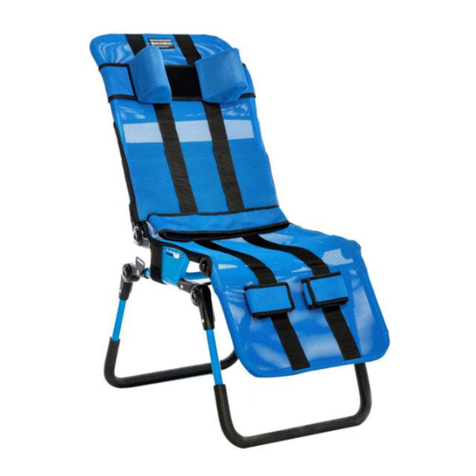
REH4MAT
REH4MAT AKVOSEGO user manual

Unicare Health
Unicare Health Breezy Basics2 Instruction & safety manual

Shoprider
Shoprider XtraLite Jiffy UL7WR-10 user manual

Amylior
Amylior LOGO SILVER LightCHAIR II operating instructions
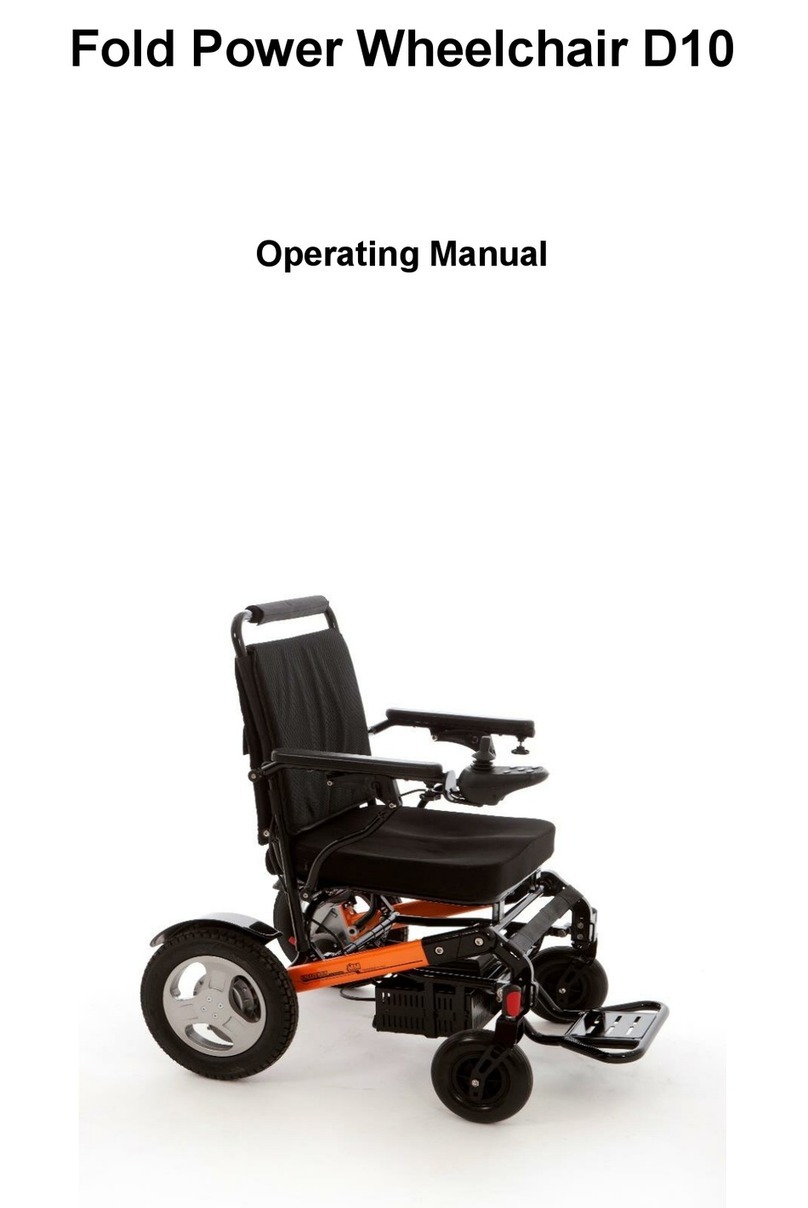
Monarch
Monarch Ezi-Fold D10 operating manual

Vermeiren
Vermeiren V300 ACTIVE user manual
